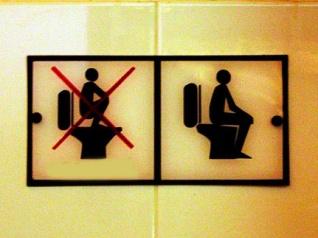Columnists
The Many Joys of An Indian Washroom
by ROSALIA SCALIA
At the risk of sounding rude, crude, vulgar, and maybe even erotic, the bathroom fixtures I encounter in India prove fascinating.
Before my trip, ironically, I contemplated the use of bidets - ubiquitous in Italy, uncommon in the U.S. - and thinking that Americans should not be so quick to dismiss them and perhaps embrace them instead. After all, Americans pride themselves on hygiene, and what could be more hygienic than the use of a bidet?
We already are a nation of multiple daily-shower-takers, supporting annually multi-billion dollar soap, toilet paper and lotion industries. Imagine the even more heightened level of hygiene American could boast about and the array of new product lines a bidet could usher into the economy!
One of my Italian cousins - -visiting to introduce her infant to the family on the American side of the pond - informed my sister-in-law helping with the baby that a particular cloth was not to be used on the baby’s face because it was her bidet cloth. Bidet cloth is not something either of us used on our babies. The closest I get to a bidet is the one located in the Palermo hotel bathroom [and in all the Italian hotel bathrooms] on a trip for this same cousin’s wedding.
At the airport, our exuberant Italian relatives welcomed us, giving my sister-in-law and me enormous bouquets of red roses. Independent of each other and minus necessary vases, we deposited these bouquets into the bidet bowls at the hotel, no doubt, irking the maid staff with our sophisticated ignorance.
Later, we both found the bouquets removed from the bidets and into vases we probably should have asked for when we first arrived. To us, the bidet seemed like the perfect place with a water source to stuff the flowers.
I did not return from the Italy trip convinced that my bathroom needed a renovation so it could include a bidet. They take up space, for starters, and to the uninitiated, all those faucets and valves make it appear scary and easily breakable. Or easily clogged. Another mechanical device with the capacity to be clogged would not fare well in a household that requires the commode to be dismantled once or twice a year because of something inappropriate being flushed.
The last time, a 10-year old in my household argued that the dog had dropped into the commode and then flushed a plastic yogurt drink bottle that required a plumber armed with a wax ring seal to unclog and resulted in a hefty bill. God forbid what the dog would then drop and then flush in a bidet, if a bidet does, in fact, flush.
India’s bathroom fixtures include a mini-hose attached to the wall near the commode or commode-less toilet - a kind of a 'Dyson Toilet', if you can image Sir James Dyson, the inventor of the bladeless fan, finally getting to re-inventing the toilet! - and far superior to and more efficient than the bidet.
It’s ingenious.
The mini hose offers potential for an array of functions other than its intended purpose, like cleaning the tile walls and floor, like aiming a stream of water at a too high window, etc.
In the Delhi hotel, I play with the mini-hose, aiming it in all sorts of directions to see how far the spray can go and find myself picturing how the nozzle could have multiple settings and also a hot and cold temperature control. Then I picture public bathrooms at home, all with the mini-hose in each stall, and realize it would be shortlived as soon as unruly American elementary school children and ornery teens begin using them as the perfect weapons to conduct water battles at bathroom breaks, giving new meaning to super soaker.
Perhaps I’m just lucky, or perhaps I failed to see the real India, but the genuine delight comes with the fact that I didn’t encounter any foul or dirty bathrooms while there, and this includes crowded public tourist sites and on the train where I am inadvertently introduced on my first full day to the old-fashion 'Dyson' commode-less stall only because I didn’t know that the stall with the seated commode lay just opposite to the old-fashion one.
Proud that I didn’t soil myself or my dress, that clumsy me didn’t fall over and in even on a moving train, I tell my companion, Dr Taranjit Singh, that the train bathroom provided an unexpected adventure and why. He looked at me blankly, and said, “All you had to do was open the door to the one opposite the old fashion stall for the one with the commode.”
I laugh at my lack of initiative and imagination, because as soon as he says it, it seems logical.
Americans operate on many myths, among them, the self-perception of being among the cleanest people in the world, even though some of the rankest bathrooms can be found in gas stations along busy U.S. highways. Bathroom fixtures in India prove fascinating also because before leaving for my trip, everyone - Indian-born and otherwise - advised me to bring toilet paper as if I were traveling back in time rather than across the miles, or kilometers.
Loathing to carry anything remotely unnecessary - aside from shoes, of course - I didn’t bring a single roll, figuring I could buy it there, if needed.
Still, our worldwide modern-age society with its technological advances likes to consider that we are the civilization on the earth to enjoy indoor plumbing - wangled into existence by Johns Hopkins University trained engineer Able Wolman in the early 1900s - also who figured out how to chlorinate water supplies.
[Hm-mm-mn. Is that why they call it a 'john'?]
But archeological evidence says otherwise: Bindeswar Pathak, Ph.D., D.Litt., in a paper titled “History of Toilets,” writes that archeological evidence suggests that the first recorded instance in human history of indoor plumbing can be found in India’s Harappa civilization in an ancient city called Lothal - in the Indus Valley in the Greater Punjab Region - in the year 2500 BC. Water borne toilets in each house, linked with drains covered with burnt clay bricks in a system featuring manhole covers and chambers to facilitate operation and maintenance, could be the finest form of sanitary engineering in the history of human kind before it disappeared from India.
The ancient city of Ur and the Romans enjoyed systems of indoor plumbing and baths, though admittedly, the use of sanitization systems rose and fell and disappeared with each civilization.
Although the bidet seems impractical, the fact remains, a sprayed behind is a clean behind, and I return from the India trip convinced my bathrooms need renovations so that they, too, can feature the ingenious mini-hose attachments near the commodes.
And neither the 10-year-old, nor the dog, would be allowed to aim the mini-hoses at each other, regardless of what either of
them decides to drop into and then flush down the toilet!
January 16, 2012
Conversation about this article
1: Shruti Sharma (Allahabad, Uttar Pradesh, India), January 16, 2012, 1:07 PM.
Ms. Scalia: you're fortunate that you got to remain in Punjab and its general vicinity. Lucky you weren't dragged through the rest of India, especially its Hindi belt - where I live. Many an Indian will tell you that the "rest of India" is a strong argument for replacing India's flag with one depicting a man defecating on the roadside, instead of the wheel in the centre of the flag. That should tell you of the real state of bathrooms in much of India! The mini-hose? Never heard of by more than 95% of the people in this country!
2: Baldev Singh (Bradford, United Kingdom), January 16, 2012, 1:22 PM.
Amazing article and one in which the subject would be taboo for most Indians! Well done, Rosalia, because hygiene is non-existent for over a billion Indians, especially with the lack of soap in virtually every roadside stop, public and government washroom! Yes, Punjab gave the world its the first civilization 5000 years, and did so with clean hands!
3: R. Singh (Canada), January 16, 2012, 5:26 PM.
During our life-long sojourns there, the norm was to hold on and on, until one was ready to burst, for the fear of having to enter a public toilet.
4: Rosalia (Baltimore, Maryland, U.S.A.), January 16, 2012, 8:16 PM.
Thank you all for reading! Mr. R. Singh in Canada - that holding on is not just limited to visits to India but for public toilets in general. As a child, my mother and grandmother had warned against using public toilets, and my mother, now 83, continues to refuse to use them. This makes traveling anywhere with her and my two aunts - all around the same age - a bit of an ordeal. Baldev - many of my Indian-born friends told me that I didn't see the real India and that I must return to do so! I hope to return to see the real India sooner than later! If you ask my mother, she'd tell you the same thing about Italians and hygiene. I don't know if this is her memories of the past, but recently, I sat with her watching a variety show on R.A.I, Italian TV beamed into their living rooms thanks to Dish. I admired the good looks of the Italian men and how well they dressed, how snappy they looked in those gorgeous suits. Without missing a beat, she said, "You wouldn't be saying that if you were sitting next to them because they don't bathe, throw on cologne to mask the smell and then step into those clothes." Of course, the way she said was funny because she used those Italian words with double meanings, but her point was made: not all Europeans savored close encounters with soap and water. Shruti - the term "the Hindi belt" fascinates me. Where is "the Hindi belt" in a country known as Hindustan. Isn't the whole country a Hindi belt? In a short trip - two weeks that blinked by in a minute - I didn't see half the sites I wanted to see so I hope to return to see them and also to see again my beloved friends. Once again, many thanks for reading!
5: Gurmeet Kaur (Atlanta, Georgia, U.S.A.), January 16, 2012, 9:28 PM.
I beg to disagree but the most ingenious piece of "bottom hygiene" was neither invented in India nor in Italy but in our very own U.S.A. We have been using it for over half a decade in each of our toilets and love it. It is called USABidet. And don't worry about the teenagers, the dog or the ten year old - they can't mess with it.
6: Baldev Singh (Bradford, United Kingdom), January 17, 2012, 8:30 AM.
Thank you, Rosalia, for a thought-provoking feature.
7: Rosalia (Baltimore, Maryland, U.S.,A.), January 17, 2012, 1:57 PM.
Gurmeet ji - Looked up the USABidet and, with all due respect, the mini-hoses offer multiple uses. I'd choose the mini-hose over USABidet any day, except I'd want a hot/cold temperature nozzle that also, like the Waterpic shower head, provides an array of spray functions as well.
8: R. Singh (Canada), January 18, 2012, 3:38 PM.
Criticism of toilets in India is not an idle criticism but a cry from the heart, for better facilities and a pride in cleanliness - the ritual bathing and dipping in rivers and ponds by Hindus notwithstanding. Well, I am hoping I can encounter the new contraptions on my next visit, but as far back as the recent past goes, there were no nozzles or hoses of any sort, not even a tap to hang them on to, in any public toilet encountered on a 150+ mile journey from Delhi to Nainital. One is lucky if a few drops of water can be found in usable form. The sheer dirt and filth floating around and never-cleaned commodes, lack of water, and horrendous smells, still linger on as one long nightmare of encounters with public toilets on the journey across India. I will be the first one to dance and sing about my great fortune, if I find this wonderful stuff outside of some overpriced tourist places. Secondly, just as there is a French-speaking province in Canada, there is a belt of Hindi-speaking region in central "Hindustan" for not all Indians speak Hindi as a native language - encompassing Uttar Pradesh, Bihar, etc.






